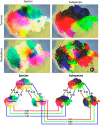Biogeography of Amazon birds: rivers limit species composition, but not areas of endemism
- PMID: 28592879
- PMCID: PMC5462822
- DOI: 10.1038/s41598-017-03098-w
Biogeography of Amazon birds: rivers limit species composition, but not areas of endemism
Abstract
Amazonian rivers are usually suggested as dispersal barriers, limiting biogeographic units. This is evident in a widely accepted Areas of Endemism (AoEs) hypothesis proposed for Amazonian birds. We empirically test this hypothesis based on quantitative analyses of species distribution. We compiled a database of bird species and subspecies distribution records, and used this dataset to identify AoEs through three different methods. Our results show that the currently accepted Amazonian AoEs are not consistent with areas identified, which were generally congruent among datasets and methods. Some Amazonian rivers represent limits of AoEs, but these areas are not congruent with those previously proposed. However, spatial variation in species composition is correlated with largest Amazonian rivers. Overall, the previously proposed Amazonian AoEs are not consistent with the evidence from bird distribution. However, the fact that major rivers coincide with breaks in species composition suggest they can act as dispersal barriers, though not necessarily for all bird taxa. This scenario indicates a more complex picture of the Amazonian bird distribution than previously imagined.
Conflict of interest statement
The authors declare that they have no competing interests.
Figures





Similar articles
-
Most species are not limited by an Amazonian river postulated to be a border between endemism areas.Sci Rep. 2018 Feb 2;8(1):2294. doi: 10.1038/s41598-018-20596-7. Sci Rep. 2018. PMID: 29396491 Free PMC article.
-
Effect of river size on Amazonian primate community structure: A biogeographic analysis using updated taxonomic assessments.Am J Primatol. 2020 Jul;82(7):e23136. doi: 10.1002/ajp.23136. Epub 2020 Apr 23. Am J Primatol. 2020. PMID: 32323350
-
Use of parsimony analysis to identify areas of endemism of chinese birds: implications for conservation and biogeography.Int J Mol Sci. 2010 May 10;11(5):2097-108. doi: 10.3390/ijms11052097. Int J Mol Sci. 2010. PMID: 20559504 Free PMC article.
-
Biogeography and speciation of terrestrial fauna in the south-western Australian biodiversity hotspot.Biol Rev Camb Philos Soc. 2015 Aug;90(3):762-93. doi: 10.1111/brv.12132. Epub 2014 Aug 15. Biol Rev Camb Philos Soc. 2015. PMID: 25125282 Review.
-
The biogeography of tropical reef fishes: endemism and provinciality through time.Biol Rev Camb Philos Soc. 2017 Nov;92(4):2112-2130. doi: 10.1111/brv.12323. Epub 2017 Feb 23. Biol Rev Camb Philos Soc. 2017. PMID: 28231621 Review.
Cited by
-
Modelling Highly Biodiverse Areas in Brazil.Sci Rep. 2019 Apr 23;9(1):6355. doi: 10.1038/s41598-019-42881-9. Sci Rep. 2019. PMID: 31015555 Free PMC article.
-
The biogeography of the Amazonian tree flora.Commun Biol. 2024 Oct 2;7(1):1240. doi: 10.1038/s42003-024-06937-5. Commun Biol. 2024. PMID: 39358549 Free PMC article.
-
Biogeographic evidence supports the Old Amazon hypothesis for the formation of the Amazon fluvial system.PeerJ. 2021 Nov 25;9:e12533. doi: 10.7717/peerj.12533. eCollection 2021. PeerJ. 2021. PMID: 34900439 Free PMC article.
-
A dynamic continental moisture gradient drove Amazonian bird diversification.Sci Adv. 2019 Jul 3;5(7):eaat5752. doi: 10.1126/sciadv.aat5752. eCollection 2019 Jul. Sci Adv. 2019. PMID: 31281878 Free PMC article.
-
Most species are not limited by an Amazonian river postulated to be a border between endemism areas.Sci Rep. 2018 Feb 2;8(1):2294. doi: 10.1038/s41598-018-20596-7. Sci Rep. 2018. PMID: 29396491 Free PMC article.
References
-
- Wallace A. On the monkeys of the Amazon. Proc. Zool. Soc. London. 1852;20:107–110.
-
- Cracraft, J. Historical biogeography and patterns of differentiation within the South American avifauna: areas of endemism. Ornithol. Monogr. 49–84 (1985).
-
- Silva, J. M. C., Novaes, F. C. & Oren, D. C. Differentiation of Xiphocolaptes (Dendrocolaptidae) across the river Xingu, Brazilian Amazonia: recognition of a new phylogenetic species and biogeographic implications. Br. Ornithol. Club 185–194 (2002).
-
- Borges SH, Silva JMC. Da. A New Area of Endemism for Amazonian Birds in the Rio Negro Basin. Wilson J. Ornithol. 2012;124:15–23. doi: 10.1676/07-103.1. - DOI
Publication types
MeSH terms
LinkOut - more resources
Full Text Sources
Other Literature Sources

